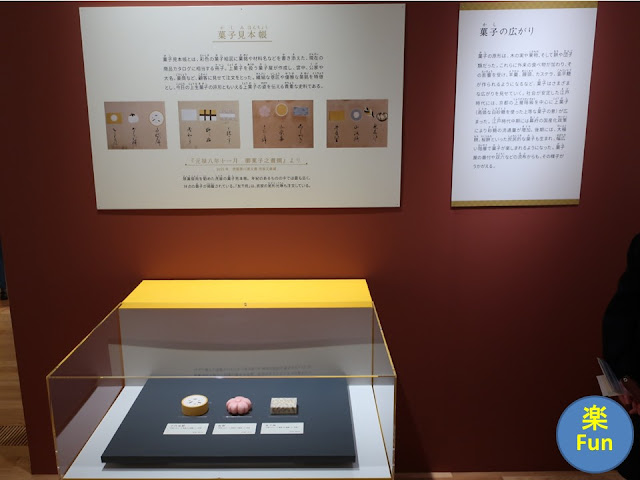Washoku means Japanese (wa) Food (shoku), which is also defined as “the traditional dietary cultures of the Japanese”. It is a traveling exhibition which started at Tokyo; it will end at Kumamoto in September of 2025. There were many exhibits including attractive replicas of dishes; it’s enough info to know washoku well.
I saw it at Matsumoto City Museum in
central Japan. Let’s start our tour.
世界的に人気がある和食。2023年10月に国立科学博物館からスタートした巡回展です。私は松本市立博物館で拝見しました(博物館の前に井戸があります)。現在は愛知、その後、京都と熊本を巡回し、2025年9月に終了します。展示品、特に食材や食品の模型が豊富! さて、見ていきましょう。
What is “washoku”? 「和食」とは?
The map on the left shows main ingredients of each region before the Industrial Revolution (from 17th to 18th century). In Japan, those were “rice and fish”.
17~18世紀(産業革命前)、世界各地では何から栄養を取っていたかという世界地図が掲げられています(左)。本州と九州・四国は、「米と魚」でした。
Ingredients the Archipelago Provides、列島が育む食材
The water is exhibited at the beginning. It is soft water which extracts components of ingredients well. It means the water is suitable to make soup stock.
一番が水。日本の軟水は食材の成分が溶け出しやすく、出汁に適した水です。
Mushrooms are popular ingredients in Japan. It is written, “Tricholoma matsutake which has strong aroma and Pholiota nameko which surface is slimy are not popular overseas”, although those are very popular in Japan.
キノコは日本で好まれる食材。香りが強いマツタケやぬめりがあるナメコは海外では人気がないそうです。
Seafood、魚介
Seafood is a mainstream ingredient same as rice.
米と並ぶ主要食材です。
Seaweed are valuable ingredients of soup stock. Other ingredients for it are dried fish and mushroom.
外国人はあまり食べない海藻。私たちは出汁材料としても珍重してきました。
Many foods such as sake or soy-sauce are made from rice and soybean.
米と大豆は重要食材。お酒や調味料にもなります。確かにそうですね。
Fermentation is crucial technology to make sake, miso-paste, soy-sauce, natto and so on, which are good for our health. Fermentation and rot are same biological phenomena. People have control microorganism well and have made precious foods.
腐敗させるのではなく微生物をコントロールして食品を作るのが発酵。酒、味噌、醤油、納豆、どれも体に良い発酵食品です。
The history of Washoku、和食の成り立ち
It is written, “When rice farming became a way of life in the Yayoi period (around two thousand years ago), the culture of rice and fish, the basis of washoku, began to take shape.”
稲作が伝来し、「米と魚」の食文化の形成が始まりました。
The ancient government prohibited to eat cattle, horse, dog, monkey and chicken; it is said to be due to influence of Buddhism. In the medieval era, Zen monks introduced the sophisticated way of cooking vegetarian meals from China; mass production of soy-sauce and sake began at the same period.
古代律令国家のもとで、牛、馬、犬、猿、鶏の食用が禁じられ、「米と魚」に集中する食文化が形成されました。時代が下って、禅僧が精進料理を中国から取り入れ、同時に、醤油や酒造りも始まります。
In the peaceful Edo period (1603~1868), people in city area could enjoy eating. The aim of eating changed from just filling their stomach to enjoying dishes with taste, eyesight and smell. Thanks to sea transport, people could easily use precious seaweed (konbu) of Hokkaido.
The ranking list of restaurants (lower right) was published. Daily meals were also improved, although those simple by today’s measure. The first place in the ranking of fish cuisine is grilled dried sardine, and the one of vegetable is simmered tofu with sake and soy-sauce (lower left).
江戸時代になると、都市部では多くの人が自由に食を楽しめるようになりました。胃袋を満たすための食事から、五感で楽しむ食事に進歩したのですね。海上交通が確立し、北海道の昆布が手にはいるようになりました。
料理屋の番付ができ、日常のおかずも充実してきました。日常のおかずの大関は目刺し(魚部門)と豆腐料理(野菜部門)ですけどね。
A wide variety of cookbooks were published. The dish in lower left imitates wheel of a noble’s carriage, which is made from egg and sliced lotus root.
料理書も充実。左下は、レンコンの輪切りと卵を使って御所車(源氏車)の車輪に見立てた料理で、その名は「源氏卵」。辛子レンコンみたいですが、名前が粋ですねえ。
Sugar began to be imported a lot and to be distributed. People could enjoy sweets. It was a huge progress.
砂糖の流通とともに、庶民の間でも大福餅や桜餅が広がっていきました。大きな進歩です。
Bento (portable lunch) became luxurious, because it was not only cooked for working outside or traveling, but also for picnic or theatergoing.
野良仕事や旅行の携行食だった弁当は、花見や芝居見物のような娯楽の場でも楽しまれるようになりました。箱も器も料理も豪華ですね。
In the Meiji period (1868-1912), Japan modernized. In 1872, beef was served to the emperor at the first time (exhibits in center). Western cuisine started spread. Chinese one also did at the same time.
On the other hand, uniquely Japanese version of Western food was developed such as curry rice, pork cutlet and croquette. Those were improved in order to go well with rice. It is written that Japanese people paid attention to Japanese food at that time. I got it!
明治5年に明治天皇に牛肉が出され(展示品)西洋料理が広がっていきます。中華料理も入ってきました。「西洋料理などが入ってきたことではじめて「和食」を意識した結果、カレー、とんかつ、コロッケなどご飯にあう日本独自の「洋食」も生まれた」と書かれています。なるほど!
After the WW2, frozen food, instant one and so on were spread. Eating alone was not rare since then. The meals and cooking utensils depicted in a long-standing manga (Sazae-san, since 1969) are exhibited.
戦後は、冷凍食品、インスタント食品などが市場に出回り、孤食化も進みました。磯野家の食卓で調理器具の変化と食事が示されています。
The panel “Sushi in the world” above is displayed at the last section “Washoku from now on”. It is written, “Some sushi, which we Japanese cannot create, might appear.” It’s wonderful that washoku including sushi becomes popular across world and new versions appear in various regions, I think.
「和食のこれから」に「世界のすし」のパネルが展示され、「日本人では思いつかない新たなすしが生まれることになるかも知れない」と書かれています。和食の世界デビューということですね。私は喜ばしいことだと思っています。
Official website: https://washoku2023.exhibit.jp/index.html
(in Japanese), accessed in December, 2024
Visited in November, 2024
Previous post: What
were the fun things for Japanese more than 100 years ago? 昔の人々の楽しみとは? (2nd
ed., three of three/第二版その3)
Next post (museum in Toyama prefecture, central Japan): Owara Kaze no Bon Festival and Yatsuo Owara Museum、おわら風の盆と八尾おわら資料館

















Comments
Post a Comment